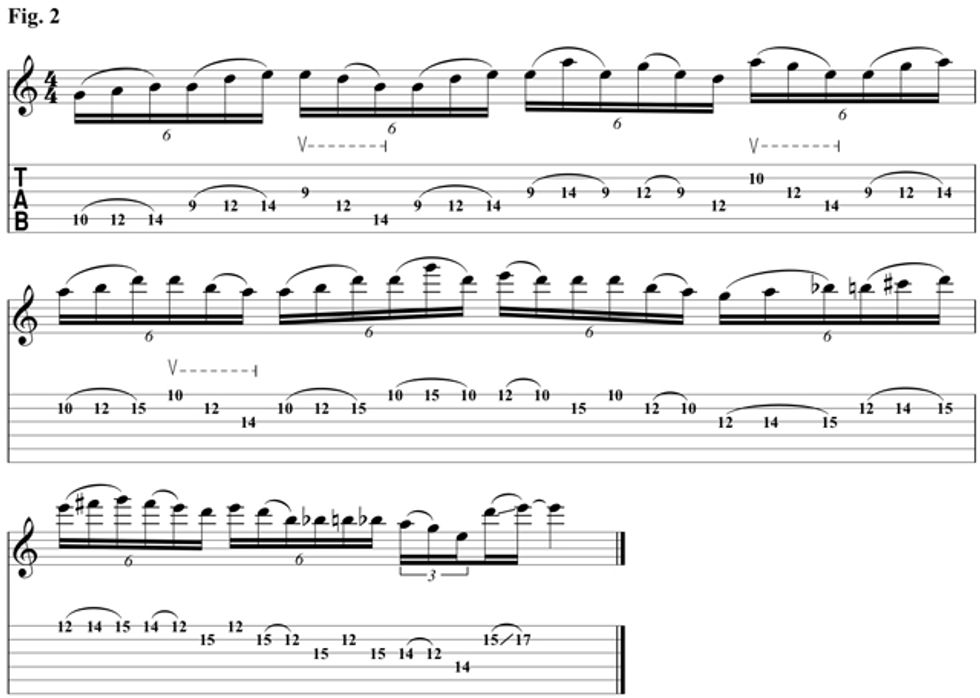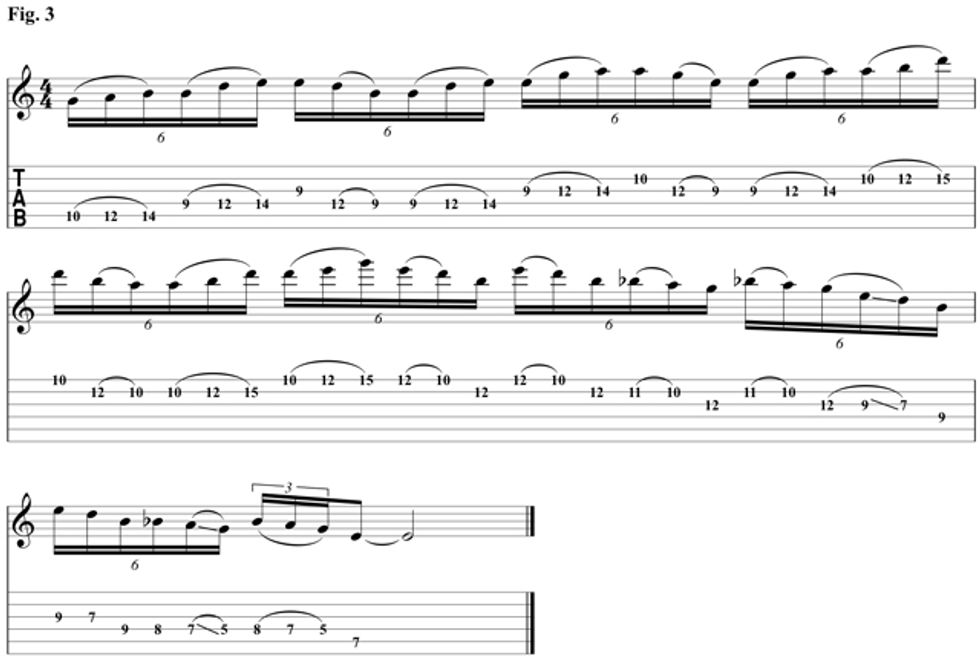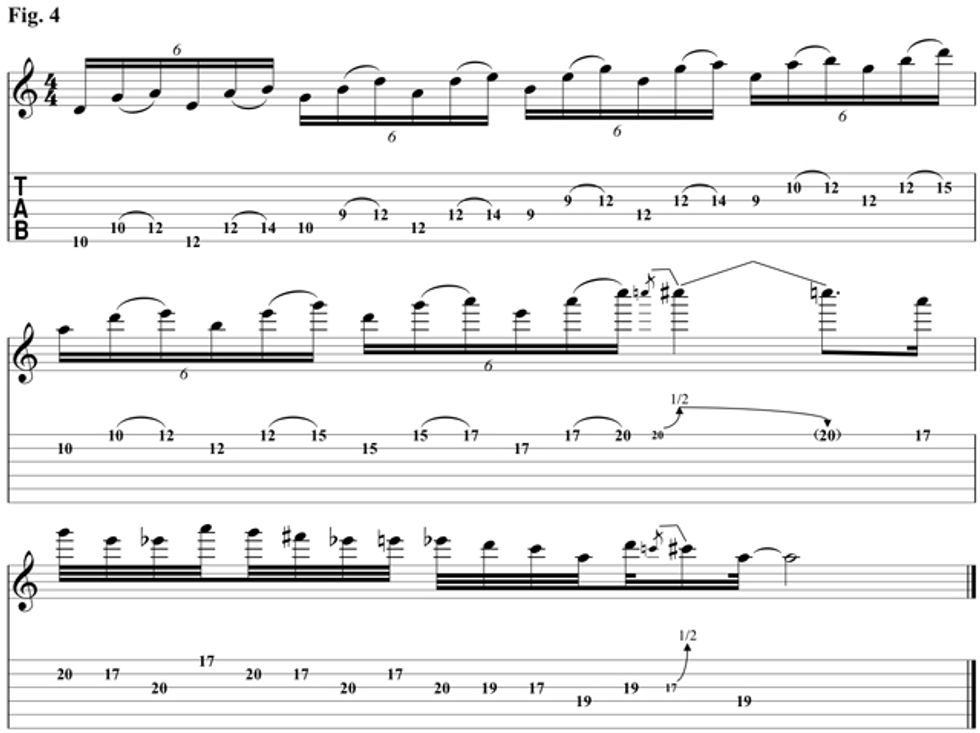The pentatonic scale is where it all begins. However, I have found a few new ways to make it a little more interesting.
Chops: Intermediate
Theory: Intermediate
Lesson Overview:
• Create three-note-per-string pentatonic scale fingerings.
• Play sequences that combine pentatonic, Dorian, and blues scales.
• Incorporate some basic outside sounds into your phrases.
Click here to download MP3s and a printable PDF of this lesson's notation.
The pentatonic scale is where it all begins. At least for me it did. Like most guitarists in the world, this scale was the first one I learned. The fact that those five magical notes sound great over any chord changes or style of music blew my mind. Especially when I heard Jimi Hendrix, Eric Johnson, George Benson, Stevie Ray Vaughan, Paul Gilbert, Greg Howe and all of the hundreds and thousands of great pentatonic shred masters. It was very inspiring and exciting that you could get this much music and diversity out of five simple notes.
Over the years I have repeatedly used this scale over and over. At times, we all fall into a rut and your basic two-finger scale can get a bit redundant. You are continually trying to leap over the binding wall of monotony. However, I have found a few new ways to make it a little more interesting, some of which I would like to share with you.
One cool trick I have found to be helpful in visualizing the scale is to look at it as a three-note-per-string scale. Although it can be anatomically challenging due to some crazy stretching, it can give some creative solutions to breaking out of your usual go-to licks. In Fig. 1 you can see a G major pentatonic (G–A–B–D–E) scale fingering that can also be seen as smashing two pentatonic patterns together. This will help you create more of your own fingerings by visualizing it this way. One thing you will notice is that the notes repeat themselves within this fingering, some people might not like this, but personally I dig it.
Now that we have the fingering, lets get creative. In Fig. 2, I make a sequence and combine some legato and sweeping techniques to get through it in the most fluid way possible. At the end of this lick, I slip into E Dorian (E–F#–G–A–B–C#–D) just to finish it off so it doesn’t sound obvious—like you’re running up a scale. It’s a cool lick that works over either an E minor or a G major vamp, and is guaranteed to melt faces!
Speaking of melting faces, Fig. 3 is another barnburner of a lick. Again, I am using the same pattern, just with a different sequence. My favorite part of this lick is ending with the three-note-per-string E blues scale (E–G–A–Bb–B–D). This sounds great over an E7 chord. The important thing in this pattern is to take this blueprint, but move it around in different keys. Some keys will be physically harder then others, but don’t be afraid to push your boundaries. The other thing is to find patterns up the neck in the same key so you can come up with your own licks. Different patterns maybe more comfortable and work better for you as well, so it pays to experiment—everyone is different.
Fig. 4 is something that is a bit more colorful. Once again, I am still using the same fingering patterns, although I am not thinking of them as three-notes-per-string. The trick is using an E minor pentatonic scale (E–G–A–B–D), which gives you the 9th (B) over an A minor chord. Then at the end of this passage I go into an A minor blues scale (A–C–D–Eb–E–G) to bring it back home.
I have always had a gravitational pull towards notes that sound outside. I usually end up playing quite a bit of pop music, and the typical belief is that there isn’t any room to be going outside. On the contrary, there is a way to get away with some outside notes. Fig. 5 is a really cool way to do this. The idea here is to slide in and out of the pentatonic scale from a half-step below. This is something I like to call “inside outside” because if you take a look at all the notes, most of them are inside. The cool thing with this concept is you can be as creative as you like, but the trick is to always land back home in the pentatonic scale. You don’t want to hang on the “out” notes unless you’re in some sort of fusion-jazz setting where this would be appropriate.
We take things a little more out with Fig. 6. This is pretty much a variation on Fig. 5, but you’re now just taking the concept and going in the other direction.
So in conclusion, take a basic scale and explore, be creative, have fun, experiment, and be brave. Use your best judgment when it comes to these kinds of licks and tricks, and build your own cool versions or take what I’ve shown you and make it your own. Simple strong core work can always be decorated and embellished. Take the same recipe but change subtle ingredients to create a new flavor and you will never fail to “Shred The Gnar!”
 Since graduating from Musician's Institute in 2004, Justin Derrico has toured with artists such as The Calling and Robin Thicke, and also performed with Tina Turner and Beyonce at the Grammys. He is currently touring with Pink as well as playing in the house band for NBC's hit show, The Voice. For more information, visit justinderrico.com.
Since graduating from Musician's Institute in 2004, Justin Derrico has toured with artists such as The Calling and Robin Thicke, and also performed with Tina Turner and Beyonce at the Grammys. He is currently touring with Pink as well as playing in the house band for NBC's hit show, The Voice. For more information, visit justinderrico.com.






